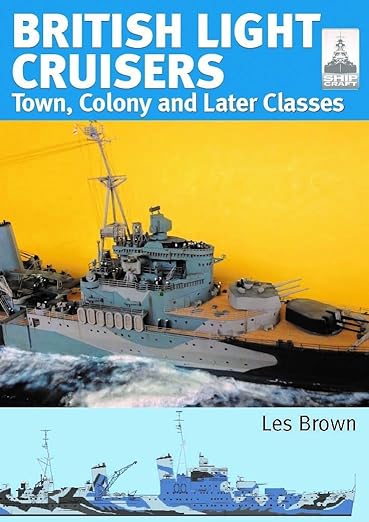
British Light Cruisers. Town, Colony and Later Classes. ShipCraft 33. By Les Brown. Seaforth Publishing, Barnsley, 2024. ISBN 978-1-3990-3753-2
Reviewed by David Hobbs
Les Brown has an international reputation in the modelling community and is the author of many of the titles in the Seaforth ShipCraft series. Like its predecessors, however, this book offers much more than an appreciation of some of the magnificent models that have been created to portray cruisers in this group.
It contains a concise design history of the subject classes and details of the modifications subsequently carried out on individual ships culminating with the post-war Tiger class and their conversion into expensive and not very effective helicopter-carrying command ships. There are also well-researched colour illustrations by George Richardson showing wartime camouflage schemes and accurate plan and side-view drawings of representative ships between 1939 and 1969.
Modellers will find pages giving details of the variety of kits of the subject ships produced over the years in a variety of scales ranging from 1:1200 to 1:128 in materials that include plastic, resin and card. There is reference to a model in the latter scale with a GRP hull that can be built as a working model by anyone who has the time and enthusiasm. The author also describes an array of accessories in brass, wood, plastic and resin for those who want to create highly accurate models with guardrails, wooden decks, gun barrels, masts, yards and rigging that are as accurate to scale as possible. As in other titles in the series, there is a showcase section with coloured photographs of some representative models. Those shown include HM Ships Belfast, Sheffield, Nigeria, Tiger and Gambia made by different modellers in a variety of scales from different kit manufacturers. The 1:350 model of Belfast by Ian Ruscoe as she appeared in 1943 stands out among these and is used as the book’s cover picture.
This book’s focus is on British cruisers designed with triple 6-inch turrets although the three Tigers were rearmed during their protracted construction with twin automatic 6-inch turrets. Some of these ships went on to serve with the Indian, Canadian and Peruvian Navies but none served with the RAN. There is, thus, no direct connection with Australia but the book offers a valuable quick reference to an important group of warships in the context of British designs. Some of them served with the BPF and RN Far East Fleets after 1945 and will be familiar to an older generation of Australians. The ShipCraft series come together to offer an interesting source of information about a variety of ships and this volume plays its full part among them. It is printed to a high quality and its UK recommended price is very reasonable. I recommend it highly, both as a technical and illustrative description of the ships and as a source of information for would-be modellers.



